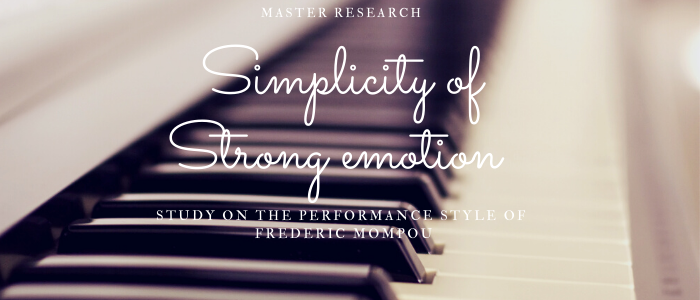1. Abstract
3. Oeuvre
4. Influences
7. Analysis of Cants Màgics
7.1. Enèrgic
7.2. Obscur
7.3. Profond-lent
7.5. Calma
INTRODUCTION
Cants Màgics was composed in 1919, when Mompou was only twenty-six. It was conceived in his hometown, Barcelona, in a time of great political uncertainty and turbulence. The break of the First World War had supposed for the young composer to temporarily discontinue his studies in the Conservatory of Paris. Mompou stayed in Barcelona from 1914 until 1920 and despite all the historical circumstances it was a productive period in his life composing the following major pieces: Impressions Íntimes, Pessebres, Scènes d’Enfants, Suburbis and Cants Màgics.
A friend of Mompou, Agustin Quintas, encouraged him to publish his work Cants Màgics. It became Mompou's first published composition. It was released by the Spanish music publisher Union in 1920. When Émille Vuillermoz and Henri Collet1 discovered this piece they wrote articles and reviews that positioned Mompou among the best composers of the time. The work consists of five movements: enèrgic, obscur, profond-lent, misteriós, calma. In the following paragraphs, I am going to explain the aspects that bring the piece together.
To start off, the short form can be observed throughout the five movements of Cants Màgics, especially the ternary form A-B-A’. This stems from the fact that Mompou strongly believed that classical music had reached a point where it was impossible to move forward一 this is, with the composing tendencies of atonality (dodecaphonism of Schönberg), expansion of tonality (Stravinsky, Bartók. etc.) and the usage of huge constructive dimensions. Therefore he proposed taking a step back to the past in order to advance. Musically speaking, it involved setting all the rationalism in music from the 20th century aside and reuse practices from the Middle Ages, Renaissance or even Baroque. Other composers of the same period such as Ravel or Stravinsky had already moved towards primitivism as a source of inspiration. However, Mompou took it to the next level.
Following the same line of thought, Mompou opted for partially omitting bar lines or time signatures in Cants Màgics, something that could not be seen since the early Baroque era. Take for instance the preludes for harpsichord of the French composer Jean-Philippe Rameau in the 18th century.
This last feature goes hand to hand to Mompou’s idea of resonance in music. For the Catalan composer music was sonority, and so the vibrations produced between two notes were the most important component to make music. Perhaps this is why Mompou’s oeuvre is mostly written in slow tempi, so as to savor the color of the chords. Cants Màgics is the perfect example to the above-mentioned aesthetic principle.
Regarding the harmonic treatment in Cants Màgics, one can observe a different perspective of tonality.
While chords have a set tonal center, Mompou adds nonharmonic notes to those. He plays with the balance of dissonant and consonant intervals. The achieved effect is the bewilderment of the listener who recognizes the sounds as familiar but slightly distorted. Something similar happens with magic, which has to do with the title of the composition. An example of this can be found on the first line of Energic: the audience identifies E minor chord, however, C# is the commented distortion.
Finally, Cants Màgics presents two types of opposite elements. On the one hand, tempo (doble moviment, 1er temps); on the other, expression markings (dark - light) which are not the conventional ones such as allegro, leggiero, pesante, scherzando... Mompou’s idea of contrary elements comes from the philosophy of the Tao, which postulates that there is unity in every opposition.
As for the expression markings, Mompou sustained that composers needed the freedom to express themselves in the way they found it most convenient —that is, with metaphors or other concepts that were more close to the willing result than the standardized indications (e.g. under the weight of sleepiness, dark, getting lost…). That makes sense taking into account that Mompou prioritized expression in music. Such is the case that dynamics were barely indicated on his scores. After all, they were just seen as a means to achieve the character that he intended.
